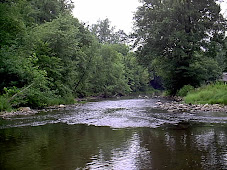Charlie Case calls it his Trout Worm, but it has proven absolutely lethal on sunfish, Perch, Crappie, White Bass, Largemout Bass and even Channel Cats! There was a time when I wouldn't even dream of going after panfish and not bringing some live maggots with me. Now I'm at the point where I haven't used live bait for panfish in several years.

My favorite is White, but other colors may work for somebody, somewhere. It works so well for me that I have only sporadically been able to force myself to put other colors on to see how well they perform. So far, White has demonstrated a dramatic dominance in effectiveness (Howzat fer a sentence?).
The thing is, there is a very specific way to rig it that produces the most hits. I've worked this rigging in a variety of ways and there's no doubt that it makes a difference. Before I describe that one little twist to you, I'll offer the obvious: being only an inch and a half long the Case Trout Worm is best set up on light line. In general I tie it onto 4 pound test Trilene XT using a 1/64oz Gold jighead. Couple that with the smallest float possible and you're in good shape. This jig lends itself well to using a small weighted float so that you can cast this featherweight combination a distance. Sometimes if the fish aren't feeling particularly peckish for whatever reason,
 I'll downsize to 2 pound Trilene XL, a 1/100 oz jighead and a very tiny Thill float.
I'll downsize to 2 pound Trilene XL, a 1/100 oz jighead and a very tiny Thill float.My biggest Crappie ever came on this rig. I was using 2# line, a 1/100 oz jig, and the tiniest This float I have (it's in the picture). It was sitting still in the water until the float just barely wobbled, then nothing. I set the hook "just in case" and came up with a Crappie that weighed over a pound and a half. Sometimes that sensitive approach is better not just for big fish but for numbers of fish as well.
I have tried using the Worm without the float, casting and retrieving it, but that didn't produce quite as well. The next best approach is in moving water, to bounce it downstream on a gold hook with the least amount of split shot possible about a foot above the hook. This does do a very good job as a plastic lure for trout, unquestionably. In still water though, where most of my panfish hunting takes place, nothing beats putting one of these guys under a float on a gold jighead (why gold with white? I'm not sure, but it beats lead grey, silver, and a plain gold hook) and a small float, slowing only to find the proper depth.
Also, when I'm fishing at distance the weighted float has always been a better choice than a slip float. Adding any split shot to the line has cut the bite ratio every time. If I need distance I go with the weighted float and nothing between the float and the jig. Up close I use the smallest Thill float possible and again, nothing between the float and the jig and using those stick floats is the most sensitive way to monitor those bites. (Though I admit to not working much with those water filled floats; they might be really effective in soft-bite situations).
Now, what about that little twist I mentioned,
 that little twist that alters this jig from a good lure to a great one? It's all in where the knot sits on the jighead. If you take a moment to make sure your knot is on the backside of the jighead, so that the tail of the Worm sticks upward when you hang it from your hand to check it out, you'll get more bites, period. I can only guess that the tail action is more pronounced in this position.
that little twist that alters this jig from a good lure to a great one? It's all in where the knot sits on the jighead. If you take a moment to make sure your knot is on the backside of the jighead, so that the tail of the Worm sticks upward when you hang it from your hand to check it out, you'll get more bites, period. I can only guess that the tail action is more pronounced in this position.That's actually what got me to buy these things inthe first place. I was at O'Donnell's in Portersville and the owner had set up a display to show the fluid movement of the worm in water. He set up a tall flexible piece of metal with a long spring coming horizontally out of the top. The end of that spring was over a tall glass vase filled with water. From the end of the spring a short piece of line dangled a Trout Worm in the vase. Being on the spring allowed you to touch it lightly and see how even the most gentle movement sends the tail wiggling.
That was all I needed to embed that image onto the backs of my corneas for the next month. See, I've learned to discipline myself against impulse buying in the bait store...usually. I just couldn't get that display out of my mind though, and soon bought my first pack. I haven't been without them since!

